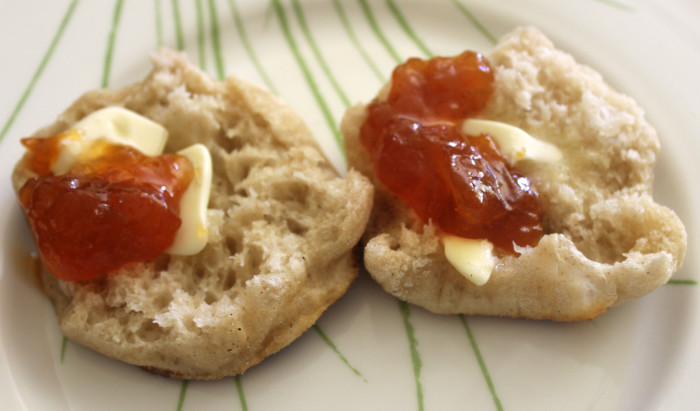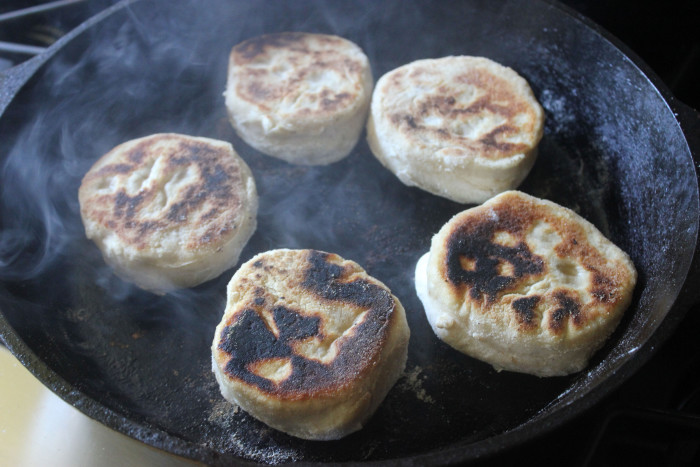Everybody tells stories. They exaggerate. They may lie. It’s all part of life. When your spouse does, then you have to consider what to do. You can nod yes and let her think you believe her. You can make a face, but not say “no” to her, letting the face alone enough convey the message that she’s been discovered.
And so this I Sunday I had to react to my wife. She said something outrageous. And I could not constrain myself.
“That’s absolutely not true,” I began. “It cannot be true.” I said this all with no meanness but I was kinda peeved that she say something so silly to me. Does she think I’m stupid?
God, maybe, …
And then Suzen rather blatantly and proudly shoved her open copy of Tartine Bread to me and pointed to the recipe. “See, you do make English Muffins with baguette dough.”
I was dumbfounded. Baguettes are a gift from the Grain Gods. English muffins are, I used to think, something that needed air so they could be a spare tire. Until recently, I thought the only good English muffin was on one the bottom of Eggs Benedict. Hollandaise sauce can work wonders with anything, including a tough, rough piece of bread.
And then, Suzen and I had a revelation. We were in South Portland, Maine — long story, details to come — and we came upon a Sunday morning farmers market. A half dozen vendors including a guy my age with his granddaughter were selling six-packs of homemade English muffins. “Try them,” he said. “You’ll be amazed.” I did not want the granddaughter to cry, so I dropped $4.
Fluffy, chewy, fresh, flavorful. They really were amazing. And to get more, we would have to drive 6 hours to Portland.
Inspired, Suzen turned to her favorite bread book, Tartine Bread, and found this recipe, this wonderful recipe. These muffins are bigger and softer than the store brands. Fresh off the grill — you really do make this muffin by grilling baguette dough strange as it seems — this delight is ready for butter and apricot jam. Just as pictured.
Oh, you don’t cut an English muffin open. You pull it and release the steam while spawning a million holes to contain melting butter and that jam or honey.
I don’t miss the hollandaise sauce at all. Amazing.
The Tartine team notes that the key to achieving English muffins with an open crumb is to keep the dough handling gentle and to a minimum. The dough needs a sufficient bulk rise to develop flavor and pockets of air throughout.
English Muffins
Yield: 12 to 14
Ingredients:
- 1 recipe baguette dough [like the one in Tartine Bread]
- Mix of rice and all-purpose wheat flour for dusting
- Cornmeal [optional]
- 1 cup [1 stick] unsalted butter
Preparation:
Prepare the baguette dough according to the recipe. Allow the dough to undergo bulk fermentation for 1 to 4 hours. During this time, give the dough one or two light turns.
Place a kitchen towel on a rimmed baking sheet and dust with rice flour mixture. Be sure to flour the towel well. Otherwise, the muffins can stick, and if they are forced later from the towel, they will be misshapen and will not rise evenly when cooked. Although the use of cornmeal rather than flour gives English muffins their trademark look, it tends to burn when the muffins are cooked on the griddle.
After the bulk fermentation is complete, turn the dough onto the well- floured towel and let relax for 10 minutes. Dust the top with rice flour mix mixture and press the dough from the middle outward until it is ½ to 1 inch thick. Evenness is more important than exact thickness. Cover with a kitchen towel and place in the refrigerator to complete the rising overnight.
Remove the dough from refrigerator about 10 minutes before cooking the muffins. Have ready a cast-iron skillet or griddle, a 1-inch round cookie cutter, and a spatula. Melt the butter in a small saucepan over high heat. When the butter begins to boil, pour it through a fine-mesh strainer into a heatproof cup. The butter does not need to be perfectly clear; removing most of the milk solids is sufficient to prevent scorching.
Heat the skillet over medium-low heat. Add just enough of the clarified butter to coat the bottom of the pan. Using the cookie cutter, cut rounds from the dough as you are ready to place them in the pan. Carefully pick up each round and lay it in the pan. A 12-inch skillet will hold two or three rounds. After 2 minutes, the muffins will puff nearly 2 inches high. Don’t worry if they puff unevenly— they will even out when turned. When the undersides are golden brown, use the spatula to turn the muffins. Press them lightly with the spatula so that they lie flat. Cook until the second sides are golden brown, 2 to 1 minutes more. The tops and bottoms should be golden brown and crisp, and the edges light and soft.
Remove the muffins from the skillet and serve warm or let cool on a rack. Wipe the skillet clean and repeat to cook the remaining muffins. If you like, dust the finished muffins with cornmeal.
To serve, split the muffins with a fork and pull apart. The muffins will keep at room temperature in a bread box or wrapped in waxed paper to retain moisture for 2 to ] days as long as you toast them before serving. English muffins freeze well in a freezer-proof container. Thaw at room temperature for 2 hours and toast to restore.
Source: Tartine Bread by Chad Robertson [Chronicle Books, 2010]
Photo Information [top]: Canon T2i, EFS 60mm Macro Lens, F/4.5 for1/40th second at ISO‑500
Photo Information [bottom]: Canon T2i, EFS 60mm Macro Lens, F/4.5 for1/60th second at ISO‑1600


